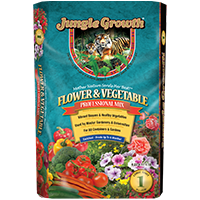Shopping for new bedding plants for your garden is a time of joy, when imaginations run wild with the possibilities. But you’ll save money and avoid disappointment if you take some time first to plan your garden, take care in choosing healthy plants, and follow a few easy guidelines for giving them a healthy start in their new homes.
Buying Healthy Plants
Even if you grow your own bedding plants from seed, chances are you will find yourself looking for some annuals or perennials to fill in the gaps. Be sure to purchase young and healthy bedding plants that will grow into magnificent adult plants.
Annuals are most commonly sold in 4 or 6 cell packs. Instead of buying those plants in full bloom, look instead for plants that have many full buds, with sturdy stems and healthy foliage. Avoid purchasing any plant with signs of rot or mildew and examine the roots. They should be well developed, holding the soil together, but should not be overly pot-bound or showing signs of rot. Pay close attention to plant labels. Different varieties of the same species can have very different growing habits, characteristics, and requirements.
Perennials are usually sold in single pots ranging up to a gallon in size. Top growth should be full, with sturdy stems and healthy leaves. The root ball should be firm, but not overly congested. Keep in mind that smaller plants are younger, meaning they will not reach their full blooming performance for several years.
Planting
The best time to plant bedding plants is on a cool day with overcast and maybe even a very light rain. When planting on a bright sunny day though, it is best to wait until the late afternoon in order to create less shock to the seedlings. Before planting, amend poor soils by mixing in well-composted organic material. Try using organic compost or enriched Garden Soil. Moisten the bed and the bedding plant root balls lightly. Remove the plants from individual cells, but be careful not to damage the main roots or stem. Carefully tease the roots with your fingers or a knife if they are pot bound.
Dig a hole that is slightly larger than the root ball, and position the plant at the same depth as it was growing originally. Firm the soil around the new plant, and water thoroughly. Continue to keep the area well moistened for a couple weeks or until plants show vigorous new growth.
Avoid the temptation to position plants closer than they are recommended. Crowded plants will compete with each other for nutrients, and poor air circulation may encourage disease. Try under planting young shrubs and perennials with annuals until they reach their peaking size. Finally, in order to retain soil moisture and reduce weed development, apply a layer of mulch to the bed or border.
Care
Feed all plants every time you water with an all-purpose plant food that promotes rapid blooming, rich color, and strong root development in all flowering and fruiting plants.
Water with a deep-soaking method in order to encourage deep root growth, and to discourage weed development. Use a wand attachment on hand held sprayers to water and feed plants at their base as much as possible. This helps avoid damaging blossoms and disease growth on foliage. If using an overhead sprinkler, water early in the day so foliage can dry before nightfall.
Deadheading spent blossoms will encourage extended blooming for many varieties. You might want to let some blossoms, like coneflowers and sunflowers, go to seed for the benefit of neighborhood birds. Many annuals will self-seed, producing new plants for next season. While these can produce some pleasant surprises, often the succeeding generations, particularly those of hybrid varieties, are weaker plants without the same characteristics that made their parents desirable. As a result, some people prefer to weed those “volunteers” out, replacing them with new plants.









